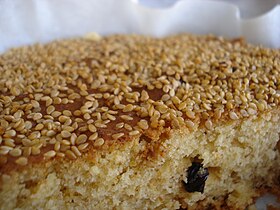

Some of this article's listed sources may not be reliable. Please help improve this article by looking for better, more reliable sources. Unreliable citations may be challenged and removed. (October 2020) (Learn how and when to remove this message)
|
 | |
| Type | Cake |
|---|---|
| Place of origin | Greece, Cyprus |
| Cooking time | 60 minutes |
| Main ingredients | flour |
| Similar dishes | vasilopita |
Fanouropita is a sweet cake recipe from Greek cuisine and is traditionally a Lenten cake, also called "lost and found cake." It is traditionally served on St. Fanourios' feast day on August 27, given to Greek Orthodox believers as a blessing.
Fanouropita is oil-based and does not contain any butter or eggs so that it can be eaten on holy fasting days. Believers offer the cake expecting "revelations" on objects or people, or to find something they are looking for.
The name fanouropita is derived from the patron saint of Rhodes, Saint Phanourios. His name translates in Greek as "the one who discloses" (Greek verb: "φαίνω").[1] He is the saint of "lost things".[2]
The tradition of fanouropita originated around 1500 AD, or 1355-1369 AD, to venerate the icon of Saint Fanourios when he was discovered untouched between ruins in Rhodes or Cyprus. In local Orthodox tradition, Saint Fanourios has been since known as the patron saint of lost objects. When a lost object is revealed or found, followers of Saint Fanourios have often baked Propitiation[clarification needed] in memory of his mother. His mother was known as a cruel sinner, sent to hell because of her shameful life. Fanourios prayed that her soul would be saved, begging God for her salvation.[3]
Fanouropita is usually 25-30 cm diameter. It is puffy, oily, aromatic, and sometimes powdered with sifted white sugar.[4]
Fanouropita traditionally consists of seven, nine, or eleven ingredients, the number varying by region. In its simplest version, propitiation has only seven ingredients.[5] The essential, most common ingredients are: flour, vegetable oil, sugar, orange juice, baking powder, nuts, and raisins. Other ingredients may include cinnamon, cloves, soda, and water.[5]
Fanouropita is blessed in church and its pieces are offered to people.[1] According to tradition, it is offered for the forgiveness of Saint Fanourios' mother, a sinful woman who was cruel towards the poor.[6]
In various areas of Greece and Cyprus, the tradition is followed by Orthodox Christians asking Saint Fanourios to "reveal" a job to the unemployed, to salvage an item that was lost, or to give health and find a groom for unmarried girls.[6][7]